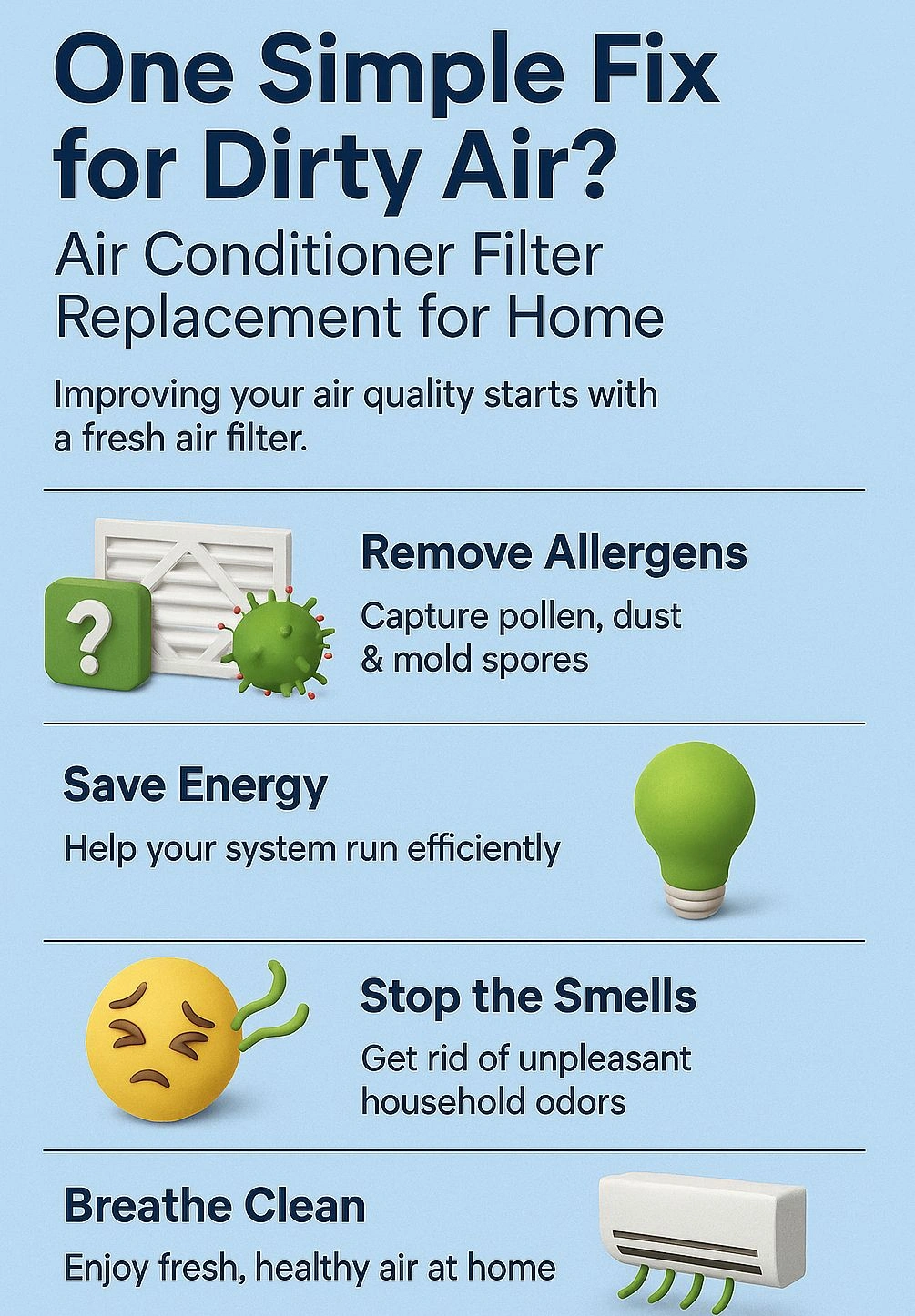If the air inside your home feels stale, dusty, or triggers allergies, the solution might be simpler than you think. One of the most effective and overlooked ways to improve your indoor air quality is routine air conditioner filter replacement for home use. It’s a small action with a big payoff—and it starts with understanding how much of your air’s cleanliness depends on that filter.
Based on our experience servicing home HVAC systems across the country, we’ve developed this guide to help you take control of your indoor air health—easily and affordably.
Key Takeaways
- Dirty air? A clogged filter is often the cause
- Replacing filters every 1–3 months improves air quality and airflow
- Clean filters protect your system from damage and lower energy costs
- Choose the right MERV rating (8–13) based on your home and lifestyle
- One $15 filter can save you from $500+ in avoidable HVAC repairs
The Simple Checklist for Replacing Your AC Filter the Right Way
We’ve walked into many homes where the air felt thick—and the filter was long overdue. Here’s a practical checklist to keep your home’s air clean and your system running like new:
- Know your filter size and typeCheck your existing filter’s dimensions or consult your system manual. Most homes use pleated, fiberglass, or HEPA filters.
- Inspect monthly, replace regularlyHouseholds with pets, allergies, or frequent AC use should change the filter every 30–60 days.
- Turn off the HVAC unit before replacing the filterThis keeps debris out of the system and protects both your unit and your safety.
- Install with the airflow arrows facing the correct directionAlways point the arrow toward the blower or fan.
- Write down the install dateMark it on the filter or use a reminder app so you don’t forget your next change.
This simple checklist has helped hundreds of homeowners avoid costly repairs, unexpected AC issues, and ongoing air quality complaints.

Real Homes, Real Improvements
What the Data—and Our Experience—Confirms
- According to the U.S. Department of Energy, replacing a clogged filter can reduce AC energy use by 5–15%
- Americans spend nearly 90% of their time indoors, making clean air essential for long-term health (EPA)
We’ve seen these stats play out in real-time—homes with regular filter changes have fewer emergency HVAC calls, fresher air, and lower energy bills.
The Expert Take: It’s the Easiest Fix You’ll Ever Make
After servicing hundreds of HVAC systems, we’ve seen the difference a clean filter makes. Systems last longer. Families breathe easier. And the AC unit runs quieter and more efficiently.
Here's what we recommend based on firsthand experience:
- Choose MERV 8–13 filters for a good balance of airflow and filtration
- Use phone reminders or a subscription to stay consistent
- Don’t wait for dust or discomfort—stay ahead of it
A $10–$20 filter and five minutes every few months can lead to healthier air and fewer breakdowns. It’s the simplest fix for dirty indoor air—and it works.
What to Do Next
- Check your current filter today
- Buy the correct size with a MERV 8–13 rating
- Mark your calendar for the next change in 30–60 days
- Sign up for filter auto-delivery if available
Share this article with a neighbor or friend—they might thank you
Frequently Asked Questions (FAQ)
Why is replacing my air conditioner filter the key to cleaner indoor air?
A dirty filter traps dust, pollen, pet dander, and other particles. When it becomes clogged, those pollutants stay in your air. Replacing the filter ensures fresh airflow and cleaner, healthier air for your home.
How often should I change my air conditioner filter to reduce indoor air pollution?
Every 1 to 3 months, depending on your household conditions. Homes with pets, smokers, or allergy sufferers should check filters monthly and replace them when dirty.
What type of air filter is best for improving indoor air quality?
Filters with a MERV rating between 8 and 13 are ideal for most homes. They effectively capture common allergens and pollutants without restricting airflow in standard HVAC systems.
Can I improve my family’s health just by changing the air filter?
Yes. Clean filters reduce respiratory irritants and airborne allergens, making a noticeable difference for those with asthma, allergies, or sensitivities to indoor air pollutants.
Is changing my air conditioner filter something I can do myself?
Absolutely. It's a simple DIY task—just turn off your system, remove the old filter, insert a new one (following the airflow arrow), and write down the replacement date.
Improving indoor air quality often starts with a simple yet powerful solution—air conditioner filter replacement for home. A fresh filter not only removes dust, allergens, and pollutants but also enhances the overall efficiency of your HVAC system. Complementing this, services like Attic Insulation Installation can help maintain stable indoor temperatures, reducing strain on your system and keeping the air cleaner. For households seeking advanced purification, Air Ionizer Installation in West Palm Beach, FL offers technology that neutralizes airborne particles for fresher, healthier breathing. Interestingly, just as air quality impacts respiratory health, physical comfort at home also extends to mobility and wellness—resources like Understanding Foot Deformities and Their Treatment Options and Reshaping Your Feet: Is It Possible emphasize how addressing underlying issues can lead to better overall quality of life. Together, these improvements create a healthier, more comfortable living environment from the air you breathe to the steps you take.
